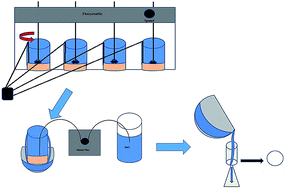当前位置:
X-MOL 学术
›
Anal. Methods
›
论文详情
Our official English website, www.x-mol.net, welcomes your
feedback! (Note: you will need to create a separate account there.)
A new analytical technique for the extraction and quantification of microplastics in marine sediments focused on easy implementation and repeatability
Analytical Methods ( IF 2.7 ) Pub Date : 2017-10-18 00:00:00 , DOI: 10.1039/c7ay01800b Julio Sánchez-Nieva 1, 2, 3, 4, 5 , José Antonio Perales 1, 2, 3, 4, 5 , Juan Maria González-Leal 4, 5, 6, 7 , Elisa Rojo-Nieto 1, 2, 3, 4, 5
Analytical Methods ( IF 2.7 ) Pub Date : 2017-10-18 00:00:00 , DOI: 10.1039/c7ay01800b Julio Sánchez-Nieva 1, 2, 3, 4, 5 , José Antonio Perales 1, 2, 3, 4, 5 , Juan Maria González-Leal 4, 5, 6, 7 , Elisa Rojo-Nieto 1, 2, 3, 4, 5
Affiliation

|
A new analytical approach has been developed to extract and quantify HDPE microparticles from marine sediments. This is the first method that has been proposed using routine laboratory equipment that incorporates slow mixing and air flux for floatation in order to collect the supernatant by overflow, using NaCl saturated solutions. The technique developed in this study comprised the preparation of an HDPE standard of different sizes and calibration curves for artificial enrichment of sediments. Two different techniques were used and compared regarding quantification: (a) stereoscopic microscopy and visual sorting and (b) confocal microscopy and image-processing counting. Microplastics of different sizes were extracted and quantified in sediments with several total concentrations of particles, and different groups of sizes were identified ranging from 0.850 to 0.100 mm. Recoveries exceeding 90% for sediments with higher concentrations of microplastics and above 80% for those with lower concentrations emphasise the potential of this methodology. This is even more remarkable if it is taken into account that different sizes were also used in these experiments. The use of this technique will result not only in a more complete assessment of microplastic concentrations but also in higher repeatability in inter-laboratory comparisons. In addition, this methodology is also suitable for applying the extraction of different polymers of microplastics using other salt solutions such as NaI or ZnCl2.
中文翻译:

一种用于海洋沉积物中微量塑料的提取和定量分析的新分析技术,其重点在于易于实施和可重复性
已经开发出一种新的分析方法来从海洋沉积物中提取和定量HDPE微粒。这是使用常规实验室设备提出的第一种方法,该实验室设备使用NaCl饱和溶液将缓慢混合和通气量合并到浮选中,以便通过溢流收集上清液。这项研究中开发的技术包括准备不同尺寸的HDPE标准和用于人工富集沉积物的校准曲线。使用了两种不同的技术并对定量进行了比较:(a)立体显微镜和目视分类,(b)共聚焦显微镜和图像处理计数。在沉积物中提取了不同大小的微塑料并对其进行了定量分析,这些沉积物中含有几种总浓度的颗粒,并确定了不同的尺寸组,范围从0.850到0.100 mm。微量塑料含量较高的沉积物的回收率超过90%,而微量塑料含量较高的沉积物的回收率超过80%,强调了这种方法的潜力。如果考虑到在这些实验中还使用了不同的大小,则这将更加显着。使用该技术不仅可以更完整地评估微塑料的浓度,而且还可以在实验室之间进行比较时提高重复性。此外,该方法还适用于使用其他盐溶液(如NaI或ZnCl)提取不同的微塑料聚合物 微量塑料含量较高的沉积物的回收率超过90%,而微量塑料含量较高的沉积物的回收率超过80%,强调了这种方法的潜力。如果考虑到在这些实验中还使用了不同的大小,则这将更加显着。使用该技术不仅可以更完整地评估微塑料的浓度,而且还可以在实验室之间进行比较时提高重复性。此外,该方法还适用于使用其他盐溶液(如NaI或ZnCl)提取不同的微塑料聚合物 微量塑料含量较高的沉积物的回收率超过90%,而微量塑料含量较高的沉积物的回收率超过80%,强调了这种方法的潜力。如果考虑到在这些实验中还使用了不同的大小,则这将更加显着。使用该技术不仅可以更完整地评估微塑料的浓度,而且还可以在实验室之间进行比较时提高重复性。此外,该方法还适用于使用其他盐溶液(如NaI或ZnCl)提取不同的微塑料聚合物 使用该技术不仅可以更完整地评估微塑料的浓度,而且还可以在实验室之间进行比较时提高重复性。此外,该方法还适用于使用其他盐溶液(如NaI或ZnCl)提取不同的微塑料聚合物 使用该技术不仅可以更完整地评估微塑料的浓度,而且还可以在实验室之间进行比较时提高重复性。此外,该方法还适用于使用其他盐溶液(如NaI或ZnCl)提取不同的微塑料聚合物2。
更新日期:2017-11-23
中文翻译:

一种用于海洋沉积物中微量塑料的提取和定量分析的新分析技术,其重点在于易于实施和可重复性
已经开发出一种新的分析方法来从海洋沉积物中提取和定量HDPE微粒。这是使用常规实验室设备提出的第一种方法,该实验室设备使用NaCl饱和溶液将缓慢混合和通气量合并到浮选中,以便通过溢流收集上清液。这项研究中开发的技术包括准备不同尺寸的HDPE标准和用于人工富集沉积物的校准曲线。使用了两种不同的技术并对定量进行了比较:(a)立体显微镜和目视分类,(b)共聚焦显微镜和图像处理计数。在沉积物中提取了不同大小的微塑料并对其进行了定量分析,这些沉积物中含有几种总浓度的颗粒,并确定了不同的尺寸组,范围从0.850到0.100 mm。微量塑料含量较高的沉积物的回收率超过90%,而微量塑料含量较高的沉积物的回收率超过80%,强调了这种方法的潜力。如果考虑到在这些实验中还使用了不同的大小,则这将更加显着。使用该技术不仅可以更完整地评估微塑料的浓度,而且还可以在实验室之间进行比较时提高重复性。此外,该方法还适用于使用其他盐溶液(如NaI或ZnCl)提取不同的微塑料聚合物 微量塑料含量较高的沉积物的回收率超过90%,而微量塑料含量较高的沉积物的回收率超过80%,强调了这种方法的潜力。如果考虑到在这些实验中还使用了不同的大小,则这将更加显着。使用该技术不仅可以更完整地评估微塑料的浓度,而且还可以在实验室之间进行比较时提高重复性。此外,该方法还适用于使用其他盐溶液(如NaI或ZnCl)提取不同的微塑料聚合物 微量塑料含量较高的沉积物的回收率超过90%,而微量塑料含量较高的沉积物的回收率超过80%,强调了这种方法的潜力。如果考虑到在这些实验中还使用了不同的大小,则这将更加显着。使用该技术不仅可以更完整地评估微塑料的浓度,而且还可以在实验室之间进行比较时提高重复性。此外,该方法还适用于使用其他盐溶液(如NaI或ZnCl)提取不同的微塑料聚合物 使用该技术不仅可以更完整地评估微塑料的浓度,而且还可以在实验室之间进行比较时提高重复性。此外,该方法还适用于使用其他盐溶液(如NaI或ZnCl)提取不同的微塑料聚合物 使用该技术不仅可以更完整地评估微塑料的浓度,而且还可以在实验室之间进行比较时提高重复性。此外,该方法还适用于使用其他盐溶液(如NaI或ZnCl)提取不同的微塑料聚合物2。











































 京公网安备 11010802027423号
京公网安备 11010802027423号